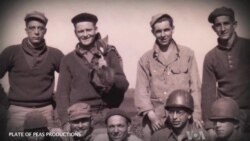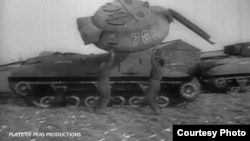Life is often stranger than fiction as filmmaker Rick Beyer found out when he learned that an American Ghost Army helped defeat the Germans during World War II.
The story was classified for decades, and after it was declassified it took Beyer eight years to piece the story together with hard-to-find footage, interviews with selected veterans, and artwork created by soldiers at the front.
Beyer created the first documentary account of this specialized unit that was charged with helping defeat the enemy by waging a war of deception.
Elaborate ruse
In March 1945, after months of bitter fighting, the Germans had retreated behind the Rhine River, their natural frontier, to mount their final defense.
For the Germans, the view from the air revealed hundreds of American vehicles. They intercepted Allied radio transmissions which appeared to confirm that two American divisions were on the ground. German observation posts reported hearing them moving in across the river.
Only nothing the Germans heard or saw was real. Hundreds of inflatable tanks and other military vehicles were props in an elaborate ruse, one of many that a small group of American soldiers staged to distract the enemy. They were known as the Ghost Army.
"The 1,000 men in this unit were basically pretending to be two divisions of 30,000 men and trying to convince the Germans that they were attacking across the Rhine in one place where the real attack was going to take place 10 miles away," said filmmaker Rick Beyer.
The operation on the Rhine was deemed a great success.
Bringing history to life
In the documentary, some Ghost Army veterans talk about how they used sounds and special effects to give the operation a realistic feel.
"I told my children it was the biggest boom box you ever saw, but it played sounds of tanks and activity," said one.
Getting the radio transmissions right was crucial.
"It's always the scenesetter. It's always the first information you're gonna get to the enemy. Because they're going to hear the radio broadcast long before the troops arrive. So you have to get the radio right," Beyer asserted. "You can't skip the other parts, because if you hear a radio that says an armored division is moving in, and then you never see any tanks or you never hear them at night moving in, you're not going to believe the radio."
Masquerade
Wherever they were stationed, The Ghost Army impersonated real units. They masqueraded as generals and set up phony command posts to deceive enemy spies.
"The people who came out of this unit is, in itself, a fascinating story," said Beyer.
They were artists and designers who got their start in The Ghost Army. During their downtime, they painted to escape the horrors of war.
"Among those artists are fashion designer Bill Blass, painter and sculptor Ellsworth Kelly, wildlife painter Arthur Singer, photographer Art Kane, very famous for a picture with all the jazz musicians on the stoop in Harlem," said Beyer.
Beyer's Ghost Army underscores the bravery of the men who went to the front lines with fake weapons that only could make noise to attract the enemy so lives were spared somewhere else.
The story was classified for decades, and after it was declassified it took Beyer eight years to piece the story together with hard-to-find footage, interviews with selected veterans, and artwork created by soldiers at the front.
Beyer created the first documentary account of this specialized unit that was charged with helping defeat the enemy by waging a war of deception.
Elaborate ruse
In March 1945, after months of bitter fighting, the Germans had retreated behind the Rhine River, their natural frontier, to mount their final defense.
For the Germans, the view from the air revealed hundreds of American vehicles. They intercepted Allied radio transmissions which appeared to confirm that two American divisions were on the ground. German observation posts reported hearing them moving in across the river.
Only nothing the Germans heard or saw was real. Hundreds of inflatable tanks and other military vehicles were props in an elaborate ruse, one of many that a small group of American soldiers staged to distract the enemy. They were known as the Ghost Army.
"The 1,000 men in this unit were basically pretending to be two divisions of 30,000 men and trying to convince the Germans that they were attacking across the Rhine in one place where the real attack was going to take place 10 miles away," said filmmaker Rick Beyer.
The operation on the Rhine was deemed a great success.
Bringing history to life
In the documentary, some Ghost Army veterans talk about how they used sounds and special effects to give the operation a realistic feel.
"I told my children it was the biggest boom box you ever saw, but it played sounds of tanks and activity," said one.
Getting the radio transmissions right was crucial.
"It's always the scenesetter. It's always the first information you're gonna get to the enemy. Because they're going to hear the radio broadcast long before the troops arrive. So you have to get the radio right," Beyer asserted. "You can't skip the other parts, because if you hear a radio that says an armored division is moving in, and then you never see any tanks or you never hear them at night moving in, you're not going to believe the radio."
Masquerade
Wherever they were stationed, The Ghost Army impersonated real units. They masqueraded as generals and set up phony command posts to deceive enemy spies.
"The people who came out of this unit is, in itself, a fascinating story," said Beyer.
They were artists and designers who got their start in The Ghost Army. During their downtime, they painted to escape the horrors of war.
"Among those artists are fashion designer Bill Blass, painter and sculptor Ellsworth Kelly, wildlife painter Arthur Singer, photographer Art Kane, very famous for a picture with all the jazz musicians on the stoop in Harlem," said Beyer.
Beyer's Ghost Army underscores the bravery of the men who went to the front lines with fake weapons that only could make noise to attract the enemy so lives were spared somewhere else.











